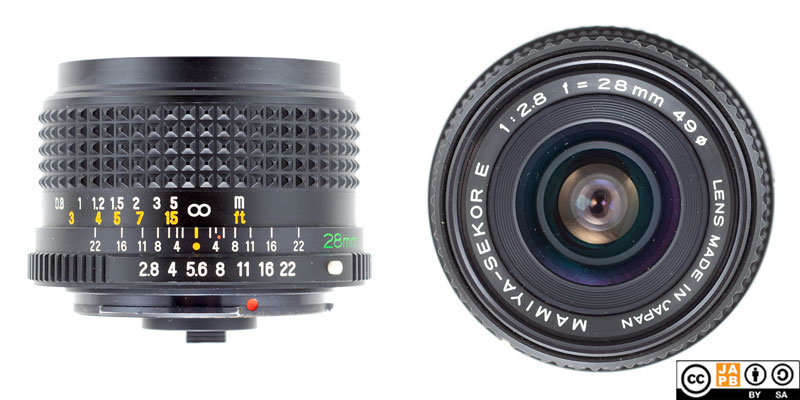Pekka Buttler, 11/2024

Specifications
The table below summarizes the lens’ key specifications (measurements based on pictured, last version of the lens):
| Brand: | Mamiya-Sekor | Lens name | E 1:2.8 f=28mm |
| Focal length(s)1 | 28 mm | Angle-of-view2 | 75° |
| Maximum Aperture | f/2.8 | In Production | 1981-1984 |
| Lens mount | Mamiya Z/E | Subfamily (if applicable) | –– |
| Length3 | 39,7 mm | Diameter4 | 61,8 mm |
| Filter ring diameter | 49 mm | Weight | 167 grams |
| Lens element count | 8 | Lens group count | 7 |
| Aperture blades (S/R/C)5 | 5 S | Focus throw | 200 ° |
| Minimum focusing distance | 30 cms | Maximum magnification | 1:8,6 |
| Has manual aperture ring | NO | Has Manual focus ring | YES |
| Aperture Mechanism Type | electronic/mechanic 6 | Aperture click stops 7 | 2.8•4•5.6•8•11•16•22 |
Further notes:
• In 1980 Mamiya introduced the Z line of cameras and lenses. Initially only with a handful of lenses:
• Mamiya-Sekor E 28mm f/3.5 (new)
• Mamiya-Sekor E 50mm f/1.7
• Mamiya-Sekor E 50mm f/2
• Mamiya-Sekor E 50mm f/3.5 Macro
• Mamiya-Sekor E 135mm f/3.5 [data sheet] (new)
• Mamiya-Sekor E 200mm f/4
• Mamiya-Sekor E 80-200mm f/3.8 [data sheet]
• The initial push of Z/E mount lenses was largely based on rehousing existing Mamiya CS lens designs (with minimal changes), with the exception of the 135 mm f/3.5 (Mamiya did not previously offer a ‘slow 135’) and the 28 mm f/3.5 (Mamiya had previously offered a well-liked NC/CS mount 28 mm f/2.8 , so many wondered why this new slower 28 mm lens.
• Whether Mamiya had always planned on rehousing the 28mm f/2.8 for the Z/E mount, or whether this happened only due to popular demand is unclear, but the Z7E 28 mm f/2.8 was launched in 1981 together with a number of other well-received improvements to the lens lineup.
• As a quirk that was typical for the Mamiya Z system, the lens does have an aperture ring, but that ring has no function on the lens itself (Mamiya Z lenses aperture rings communicated the chosen aperture to the camera, which in turn did the closing down). This has implications on adaptability (read more below).
Versions
There was only ever one version of the Mamiya-Sekor E 28 mm f/2.8. To the best of my knowledge, the lens is optically identicalwith its predecessor in the Mamiya NC/CS mount .
History of Mamiya Z/E lenses
Please see the JAPB article on all (7) Mamiya SLR lens mounts to understand the role of the Mamiya Z/E mount.
Adapting
n.B! The following applies to all Mamiya Z/E mount lenses.
This lens cannot be used natively on any current SLR or dSLRs. To use it in its native environment, you will need a Mamiya Z/E-mount film body – a ZE, ZE-2, ZE-X or ZM. While the Mamiya Z/E system remained in production for only 4 years (and was not a mega-hit), these bodies are relatively easy to find.
While the lens sports electronic contacts, these are not needed to facilitate critical functionality. However, as the aperture ring of Mamiya Z/E lenses is a dummy ring (it does not manipulate the lens’ aperture in any way – it instead communicates the aperture to the camera body, which in turn manipulates the lens’ aperture lever), adjusting aperture is a function that has to be taken care of by the adapter.
Therefore, should you aim to adapt this lens to a mirrorless camera you will need an adapter that facilitates adjusting the lens’ aperture. Luckily, every Mamiya Z/E adapter I’ve seen does offer such a functionality. However, due toMamiya Z/E lenses not being among the most numerously manufactured, special adapters (helicoid adapters, tilt/shift adapter and speed boosters) are currently unavailable.
Using Mamiya Z/E lenses on dSLRs is also possible. However, due to that the, difference in flange focal distances between the Mamiya Z/E lens and the dSLR mount (between +1,5 mm and negative 1 mm) invariably does not allow sufficient space for an adapter that allows aperture modification, these adapters are always adapters with added optics to achieve infinity focus.
Footnotes
- Focal length is (unless stated otherwise) given in absolute terms, and not in Full-frame equivalent. For an understanding of whether the lens is wide/tele, see ‘Angle-of-view’. ↩︎
- Picture angle is given in degrees (based on manufacturers’ specs) and concerns the diagonal picture angle. Rule of thumb:
> 90 ° ==> Ultra-wide-angle
70–90 ° ==> Wide-angle
50–70 ° ==> Moderate wide-angle
40–50 ° ==> ‘Standard’ or ‘normal’ lens
20–40 ° ==> Short tele lens
10-20 ° ==> Tele lens
5-10 ° ==> Long tele lens
< 5 ° ==> Ultra-tele lens ↩︎ - Length is given from the mount flange to the front of lens at infinity. ↩︎
- Diameter excludes protrusions such as rabbit ears or stop-down levers. ↩︎
- S=straight; R=rounded; C=(almost)circular at all apertures. ↩︎
- The lens communicates the selected aperture electronically, but the lens is closed down mechanically. ↩︎
- Numbers equal aperture values on aperture ring; • intermediate click; – no intermediate click. ↩︎